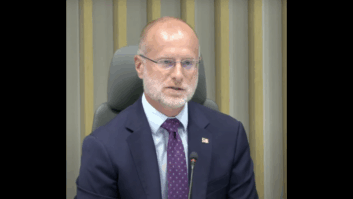In 366 pages, authors Richard Harnett and Billy Ferguson have attempted to chronicle the history of United Press International, from its origin at the beginning of the last century until its demise due to managerial mishandling and shifting market forces 92 years later.
The book is “Unipress: United Press International, Covering the 20th Century,” a 366-page hardcover from Fulcrum Publishing.
It begins with what arguably was UPI’s greatest scoop: White House Correspondent Merriman Smith, who beat the Associated Press in November 1963 with news about shots fired on a presidential motorcade in Dallas, Smith grabbing the mobile phone and refusing to relinquish it.
It ends, 37 chapters later, with the end of UPI a traditional wire service.
“The day had finally arrived,” is the last sentence. “Associated Press reporters no longer needed to hurry on the phone.”
Long ‘death watch’
Harnett, who spent 36 years of his journalistic life with United Press, died shortly after completing the manuscript. Ferguson spent 40 years as a UP and later UPI staffer. They have earned their membership in a small elite fraternity: Unipressers who have written books about their company.
The first, “Deadline Every Minute,” by Joe Alex Morris in 1957, captured the second-by-second excitement of the days when newspapers dominated the news business and depended almost exclusively on wire services for national and international news.
The tone of the second book, “Down to the Wire,” by Gregory Gordon and Ronald E. Cohen in 1990, is much darker. The sub-title says it all about what happened to UPI in the subsequent decades: “UPI’s Fight for Survival.”
Today’s UPI bears little resemblance to the UPI of old.
According to its Web site, “UPI is a global operation headquartered in Washington … (that) licenses content directly to print outlets, online media and institutions … In addition, UPI’s distribution partners provide our content to thousands of businesses, policy groups and academic institutions.”
But Tom Foty, former Washington bureau manager and executive editor of UPI Radio, speaks for most for Unipressers when he says, “UPI is far removed from the once-vital, comprehensive and innovative multimedia news and information provider that United Press International used to be.
“It appears to be a small, mostly Web-based, niche news service, marketing limited text and photo products to some secondary Web sites, ‘think tanks,’ information resellers (also known as ‘aggregators’) and short-form digital text delivery services.”
When I joined the UPI Radio Network in 1993, staffers privately told me I would witnesses the longest death watch in history. By then, as anchor Dennis Daily was quick to point out, UPI had endured five owners and two bankruptcies in seven years. Managerially and financially, it was descending into a black hole, its product maintained mostly by the pure stubborn pride of its staffers who still felt that the label “UPI” demanded a professional product.
“Unipress” reveals that management depended on that pride and even exploited it.
Underdogs
Back in what could be called the heyday of UPI, Hollywood released “Teacher’s Pet,” one of many motion pictures about the newspaper business. On the editor’s desk was a plaque that read, “The purpose of a newspaper is to comfort the afflicted, and to inflict the comfortable.”
If UPI staffers can be covered by a single blanket, it is their penchant for the underdog. That’s because, as Harnett and Ferguson point out repeatedly, UPI was an underdog. What staffers lacked in revenue and expenses, they made up for with ingenuity and spunk. In the process they earned the company a reputation for feisty, snappy writing.
It is precisely the dogged determination to compete with the bigger, and profoundly richer, Associated Press that kept Unipressers going for most of a century. In the process, the staffers forged memories and anecdotes unparalleled. They are the Tabasco that brings life to the bland salad of factual recitation. The authors make a reader anxious to keep turning the page, from one war story to another concerning the major and minor events UPI covered during the last century.
The book’s 35 pages of index, bibliography and notes are testimony to the authors’ exhaustive research. Perhaps inevitably, a project of such magnitude is going to have its errors.
Some stand out, though. The book states that the Soviet Union put the first man-made satellite, Sputnik, into orbit on Sept. 30, 1957. The actual launch was Oct. 4, a date that marked a turning point both in the U.S. neophyte space efforts and for its educational system as well.
The authors say that in 1950, Russ Jones of UP won the agency’s first Pulitzer Prize for his dramatic eyewitness reporting of the Soviet Union’s military suppression of a budding revolt in Hungary. The revolt was in 1956.
Named among the reporters sent by UPI to cover the Korean conflict is Fred Painton, who actually died in the Pacific during World War II and was the subject of one of the last columns by famed correspondent Ernie Pyle.
Staffers Edward Beattie and Walter Cronkite are mentioned hearing a plane with its engine sputtering over London during World War II. The authors say it was a German V2. But V2 missiles fell faster than the speed of sound and were not heard until they hit. The V2’s predecessor, the V1, was something akin to today’s cruise missiles. They were powered by a ramjet engine that sputtered, hence its name of “buzz bomb.”
Perhaps because I was a photojournalist for 35 years before I got into broadcast, I’m sensitive to photographers receiving proper credit. In one chapter, the authors list eight Pulitzer prizes between 1960 and 1980 won by UPI photographers. None of the names is listed. Why?
It is easy to spot that the two authors did not always coordinate their efforts. On page 89, essayist William Allen White, economist J.M. Keyes, golfer Bobby Jones, writer Edna Ferber and author Sir Arthur Conan Doyle are listed among those who had written for a United Press subsidiary, United News. Twenty-seven pages later, in a later chapter, the exact information appears again. A similar redundancy appears on pages 207 and 267 concerning the stock market.
Furgeson asked for any mistakes to be brought to his attention on the “Downholders,” the Internet chat forum for former Unipressers. He got his wish. So many replied that one member finally asked the rest to be gentle with the authors, pointing out that Furgeson and Harnett produced the book with little help from others. They have, he said, done a helluva job.
That they have. Subsequent editions no doubt will clear up most of the problems.
Recalling the teletype
What will remain is a gigantic effort to tell the story of a wire service that kept fighting until the end.
It’s a unique book if, at $50, an expensive one. But there’s not another like it; in its pages, history comes alive. Any student of journalism who has no idea what a teletype sounded like and who really wants to know what competitive journalism was like – and what it should be like – should read it with enthusiasm.
Then he or she will understand the ironic humor in a message posted by former UPI Radio Tokyo Bureau Chief Thomas Caldwell to “Deadmike,” the Internet chat forum he started for former UPI Radio staffers.
Of a wire service that had once chronicled the fall of nations and the birth of kings, Caldwell wrote that on Nov. 5, 2003, UPI reported that biologists in Canada had linked “an odd underwater farting sound to bubbles coming out of a herring’s anus.”
One can only imagine how the sound bite guys in the audio slots at UPI Radio would have handled that story. Which points out something missing on the bookshelves of journalistic history: where’s the book devoted entirely to the UPI Radio Network?
Bill Clough is news and operations director of South Texas Public Radio in Corpus Christi, Texas. During nearly six years with the UPI Radio Network he was a producer, religion editor and news anchor, and he covered the Pentagon, State Department, Senate, House and ultimately the White House.







